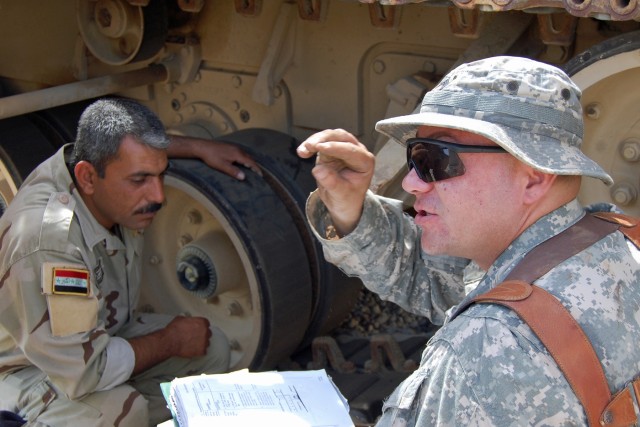JOINT SECURITY STATION AL RASHEED, Iraq - At 8:30 a.m. it is 98 degrees Fahrenheit under the tarpaulin. A group of eager Iraqi Army soldiers huddle around Sgt. Jasen Sumner as he explains how to conduct preventive maintenance checks and services on the track pads of the M1A1 Abrams Main Battle Tank. Sumner speaks, his linguist translates, and the students nod their heads in understanding.
Behind the group is a butcher board on an easel with tasks, conditions and standards written in English and Arabic, as well as a cooler full of bottled water.
It is day two of a U.S. forces-led, in-depth tank refresher course held for members of the IA at Joint Security Station Al Rasheed. This session's students include 12 soldiers and one officer from 1st Platoon, 1st Company, 4th Tank Regiment, 35th Brigade, 9th Iraqi Army Division. By September of this year, the 9th IA Div. will be fielding four battalions of M1A1s-a total of 140 tanks-purchased by the Government of Iraq to further the nation's efforts to modernize its military. The purpose of this training is to ensure that the IA soldiers' skills remain fresh until the arrival of the tanks.
"Tanking is a perishable skill," says Staff Sgt. John Rideout, lead instructor of the course. "You have to stay tanking to be proficient at tanking."
Staff Sergeant Rideout, a seven-year army veteran assigned to Company D, 3rd Battalion, 69th Armor Regiment, 1st Advise and Assist Brigade, 3rd Infantry Division, was hand-picked from3/69 Armor to spearhead the training program. In a month's time the master gunner assembled a team of four fellow armor crewmen and three Abrams tank mechanics from D Co., and together they developed 44 training modules covering everything from preventive maintenance checks and services to fully preparing each tank station-gunner, loader, driver and tank commander-for operation, with an emphasis on safety and maintenance. To ensure for a seamless bilingual delivery of the course, the Soldiers hosted the training for three linguists before beginning the IA instruction phase so that the interpreters would also be intimately familiar with the M1A1's moving parts and pieces.
Every two-and-a-half weeks until September, Staff Sgt. Rideout and his Soldiers will host the hands-on course for a new platoon of IA soldiers and leaders, with the intent of training each soldier and leader in 1st Company.
Staff Sergeant Rideout and his team, including Sgt. Sumner, Sgt. John Dunmeyer, Sgt. Anthony Ciofalo, Spc. Sean Callahan, Sgt. Daniel Valdez, Spc. Nicholas Fitt and Spc. Christopher Pettibone, developed many of the training modules around the Tank Crew Gunnery Skills Test, an Abrams tank competency program comprised of 17 basic tanking skills; they also incorporated pointers they received from U.S. civilian contractors based at the M1A1 New Equipment Training school located at the Besmaya Range Complex. As part of the M1A1 acquisition, the GoI has established the M1A1 NET and a maintenance and fuel provision package for the tanks.
"It's been an enjoyable experience working with the Iraqi soldiers," says Sgt. Ciofalo. "I feel a good sense of worth with training these soldiers on this equipment."
Sergeant Sumner, who has been an armor crewman for eight years, shares Sgt. Ciofalo's sentiments.
"I enjoy talking tanks," he says. "It's nice to be able to talk to some of these guys who are new to it and are eager to learn."
"They're all pretty excited to be able to have the opportunity to field the tanks and get the information from [the] classes," Sgt. Sumner continues.
Through the course of the day's training session, the IA soldiers use every possible opportunity to put their hands on the equipment. When they have maintenance-specific questions, Sgt. Valdez and his Soldiers are on hand to answer technical specifications.
Captain Muhned Khlid Ahmed, a 15-year veteran of the IA, says the Abrams training he and his soldiers are receiving is valuable.
"We have professional teachers," Capt. Ahmed says. "Each one of the teachers likes his job."
Private Amor Sami, who joined the IA two years ago to help his country, has in his short term of service, come to realize how vital tanks are to his military.
"The tank is very important," Pvt. Sami says. "You can control the attack [and] the fight with this gun."
The training is also forging a stronger partnership between U.S. forces and the IA.
"I feel training with the Iraqis is a vital part of forming this partnership," says Sgt. Dunmeyer. "It builds a bond when you're working together."
At the close of the day's session, Capt. Ahmed remarks on the bigger picture of the purpose of the training received, and the IA's future efforts in fielding the tanks in defense of his nation.
"As long as I have the power to work, to help people, I will work," Capt. Ahmed says. "The Iraqi people deserve help, especially at this time."


Social Sharing